Dr Julian Bennett is a British archeologist.
After leaving secondary school, Dr Julian Bennett worked as a freelance archaeologist in England and Germany, before entering the University of Durham as a mature student where he graduated with a BA (Hons) in Archaeology in 1978. After preliminary graduate study at Newcastle University, he was appointed as an Excavations Director for English Heritage, continuing with graduate studies on a part-time basis to eventually be awarded his PhD in 1991. The title of his PhD thesis was The Setting, Development and Function of the Hadrianic Frontier in Britain. From 1985 to 1995, Bennett worked for a New York travel company, guiding for institutions such as the Smithsonian and the Metropolitan Museum of Art, and working as Tour Leader and Archaeological Guide Lecturer on boat cruises around Europe and Scandinavia, the Mediterranean World, and South America.
In 1995 Bennett became a professor at Bilkent University in Ankara. His areas of expertise are: provincial and military Roman archeology, late Roman and Byzantine architecture in Turkey, the Roman Empire and the Roman army and the study of Late Antique and Medieval architecture. He has published numerous monographs and articles on various aspects of Roman and Medieval Britain and the Roman army, and is the author of two books, Towns in Roman Britain (1980) and Trajan. Optimus Princeps. A Life And Times (1997). The latter has been translated into Romanian and Russian.
Bennett's fieldwork experience extends from rural and urban salvage excavations in Britain, Romania, and Germany to his current research project, studying the architecture of the Moldavian and Ottoman castle of Belgorod-Akkerman, in the Ukraine. He was elected a Fellow of the Society of Antiquaries of London in 2002, becoming only the third person in Turkey to receive that distinction. Bennett has appeared in many TV documentaries for the BBC, The History Channel and National Geographic.
Julian has one daughter, Laura I. H. Bennett (b. 1984) and two sons, Alexander Ş. W. Bennett (b. 2006), Arthur K. W. Bennett (b. 2009).
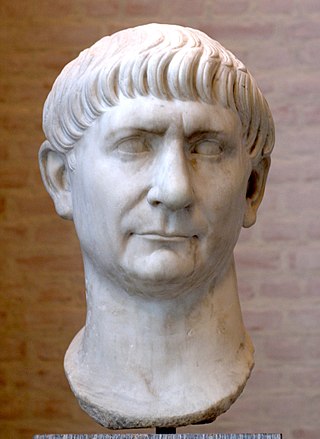
Trajan was Roman emperor from 98 to 117. Trajan was born and raised in Italica, close to modern Seville in present-day Spain, a small Roman municipium of Hispania Baetica founded by Scipio as an Italic settlement; his branch of the Ulpia gens, the Ulpii Traiani, came from the town of Tuder in the Umbria region of Italia. Trajan's father, Marcus Ulpius Traianus, also from Italica, was a senator.

Decebalus, sometimes referred to as Diurpaneus, was the last Dacian king. He is famous for fighting three wars, with varying success, against the Roman Empire under two emperors. After raiding south across the Danube, he defeated a Roman invasion in the reign of Domitian, securing a period of independence during which Decebalus consolidated his rule.
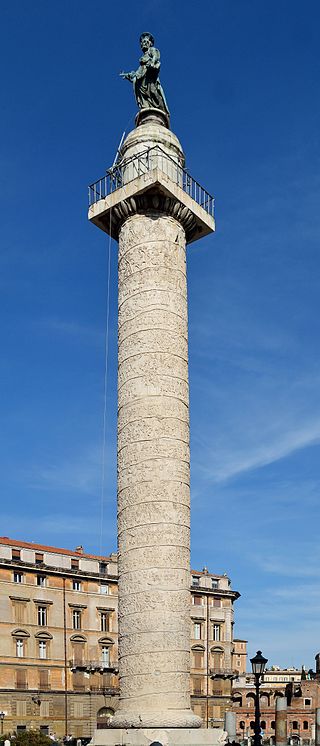
Trajan's Column is a Roman triumphal column in Rome, Italy, that commemorates Roman emperor Trajan's victory in the Dacian Wars. It was probably constructed under the supervision of the architect Apollodorus of Damascus at the order of the Roman Senate. It is located in Trajan's Forum, north of the Roman Forum. Completed in AD 113, the freestanding column is most famous for its spiral bas relief, which depicts the wars between the Romans and Dacians. Its design has inspired numerous victory columns, both ancient and modern.
Legio XXI Rapax was a legion of the Imperial Roman army. The symbol of the legion is thought to have been a capricorn.

Richard Hodges, is a British archaeologist and past president of The American University of Rome. A former professor and director of the Institute of World Archaeology at the University of East Anglia (1996–2007), Hodges is also the former Williams Director of the University of Pennsylvania Museum of Archaeology and Anthropology in Philadelphia. His published research primarily concerns trade and economics during the early part of the Middle Ages in Europe. His earlier works include Dark Age Economics (1982), Mohammed, Charlemagne and the Origins of Europe (1983) and Light in the Dark Ages: The Rise and Fall of San Vincenzo Al Volturno (1997).

Italica was an ancient Roman city in Hispania; its site is close to the town of Santiponce in the province of Seville, Spain. It was founded in 206 BC by Roman general Scipio as a colonia for his Italic veterans and named after them. Italica later grew attracting new migrants from the Italian peninsula and also with the children of Roman soldiers and native women. Among the Italic settlers were a branch of the Gens Ulpia from the Umbrian city of Tuder and a branch of the gens Aelia from the city of Hadria, either co-founders of the town or later migrants who arrived at an unknown time; they were the respective stirpes of the Roman emperors Trajan and Hadrian, both born in Italica.

Legio VII Gemina was a legion of the Imperial Roman army. It was raised in AD 68 in Hispania by the general Galba to take part in his rebellion against the emperor Nero. "Gemina" means the legion was dedicated to the legendary twin founders of Rome, Romulus and Remus, who were suckled by a she-wolf. The legion was deployed in the city called Legio in AD 74 and remained in Hispania to the end of the 4th century.
Gaius Salonius Matidius Patruinus was a Roman Senator who lived in the Roman Empire during the 1st century during the reign of Vespasian.
Lucius Vibius Sabinus was a Roman Senator who lived in the 1st century. His daughter Vibia Sabina married the emperor Hadrian.
Lucius Mindius is an unattested Roman Aristocrat who lived in the Roman Empire in the second half of the 1st century. Mindius was a Roman Senator of Consular rank. Little is known on his origins. In 84, Mindius married Salonia Matidia, the niece of future Roman Emperor Trajan, becoming her second husband. Matidia was previously widowed from her first marriage to suffect consul Lucius Vibius Sabinus, who left Matidia a daughter Vibia Sabina.
Quintus Vibius Secundus was a Roman Senator who was active during the reigns of Domitian and Trajan. He was suffect consul for the nundinium of March to April 86.
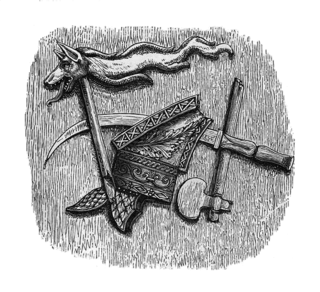
Duras, also known as Duras-Diurpaneus, was king of the Dacians between the years AD 69 and 87, during the time that Domitian ruled the Roman Empire. He was one of a series of rulers following the Great King Burebista. Duras' immediate successor was Decebalus.
Criton of Heraclea was a 2nd-century Greek chief physician and procurator of Roman Emperor Trajan (98–117) in the campaign in Dacia. He is perhaps the Criton mentioned in Martial's Epigrams.
Dacica is a Latin work by Roman Emperor Trajan, written in the spirit of Julius Caesar's commentaries like De Bello Gallico, and describing Trajan's campaigns in Dacia.

King Manisarus was a 2nd-century king of the Corduene, which was a small vassal state during the Roman Empire. He has also been described as "perhaps prince of the Praetavi, whose capital was Singara". During his rule he took control over parts of Armenia and Mesopotamia, and Osroes I of Parthia declared war on him. Manisarus petitioned the Roman Emperor Trajan, offering him territory taken from supporters of Osroes in return for his support, an offer which was evidently accepted. Trajan also acquired the kingdom of Corduene at this time but only temporarily.
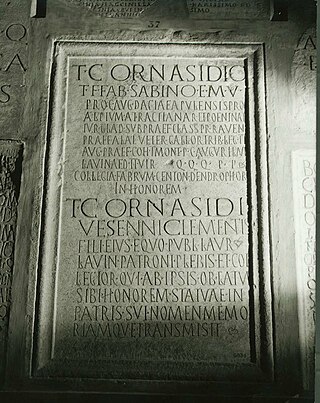
The tres militiae was a career progression of the Roman Imperial army for men of the equestrian order. It developed as an alternative to the cursus honorum of the senatorial order for enabling the social mobility of equestrians and identifying those with the aptitude for administration. The three posts, typically held over a period of two to four years, were Praefectus cohortis, Tribunus angusticlavius, and Praefectus alae.
Titus Sextius Magius Lateranus was a Roman Senator who lived during the second half of the 1st century and first half of the 2nd century. Lateranus served as a consul ordinarius in 94 as the colleague of Lucius Nonius Calpurnius Torquatus Asprenas. He is known entirely from inscriptions.
Titus Sextius Cornelius Africanus, also known as Titus Sextius Africanus, was a Roman Senator who lived in the Roman Empire in the second half of the 1st century and first half of the 2nd century. He served as an ordinary consul in 112 as the colleague of emperor Trajan.
Titus Sextius Lateranus was a Roman senator active in the second century AD. He was ordinary consul in the year 154 as the colleague of Lucius Verus. Lateranus is also known by a more full name, which has been restored in two different ways: Titus Sextius Lateranus M. Vibius Ovel[lius?...] Secundus L. Vol[usius Torquatus?] Vestinus, or Titus Sextius ... M. Vibius Qui[etus?] Secundus L. Vol[usius Torquatus?] Vestinus.
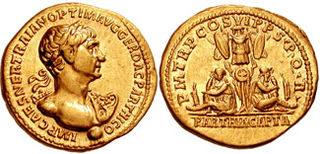
Trajan's Parthian campaign was engaged by Roman Emperor Trajan in 115 against the Parthian Empire in Mesopotamia. The war was initially successful for the Romans, but a series of setbacks, including wide-scale rebellions in the Eastern Mediterranean and North Africa and Trajan's death in 117, ended in a Roman withdrawal.